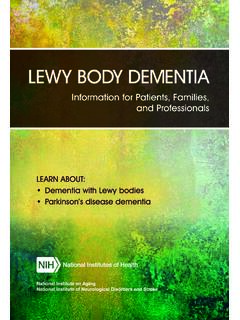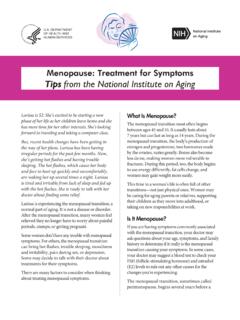Transcription of Workout to Go - National Institutes of Health
1 Wo r kou t to GoA Sample exercise Routine from the National institute on Aging at NIHW orkout to Go Are you just starting to exercise ? Getting back into a routine after a break? Wanting to keep up your physical activities away from home? The 13 exercises in this sample Workout can help. In this booklet, you ll find easy-to-follow strength, balance, and flexibility exercises that you can do anytime, of the great things about physical activity is that there are so many ways to be active. This Workout is only one of them. The secret to success is to be creative, find activities you enjoy, and keep sample Workout is part of Go4 Life , an outreach campaign from the National institute on Aging at NIH to help you fit exercise and physical activity into your daily life.
2 For more exercises, motivational tips, and other free materials, visit our website: Go4 Life is a registered trademark of the Department of Health and Human Ready Before you begin, here are a few things to keep in mind. Safety always comes you haven t had regular checkups, you might want to talk with your doctor about your Workout plans. Ask if there are any reasons to modify your program or adjust the exercises to do them safely. Always listen to your body and do what you can as long as you re comfortable. Drink plenty of your doctor has asked you to limit fluids, be sure to drink water when you exercise . Many older adults don t feel thirsty even when their body needs fluids.
3 Wear comfortable sure to wear clothes that let you move freely. 2 Get SetFor the Workout , you ll need two tennis balls, a sturdy chair with arms, a towel, and two equally weighted objects like hand or wrist weights, soup cans, or water bottles. You may need to use 1- or 2-pound weights when starting out. As the exercises become easier, gradually add more will start the sample Workout by warming up. Then, move on to the strength and balance exercises. For each exercise , we show one set of 10-15 repetitions. Try doing 3 sets, and then cool down with the flexibility YOU NEED3 Safety TipsBreathe regularly during strength exercises.
4 For example, breathe out as you lift the weight, and breathe in as you relax. When doing leg lifts, breathe out as you lift your leg and breathe in as you lower smooth, steady movements when lifting prevent injury, don t jerk or thrust weights into your arm and leg joints slightly locking your arm and leg joints in a tightly straightened a sturdy chair with arms. Make sure the chair is stable enough to support you when seated or when holding on during the slow, steady bounce into a stretch. Always bend forward from the hips, not the you keep your back straight, you re bending the right if you feel might feel some soreness after you exercise , but exercise should not hurt or make you feel really tired.
5 In fact, in many ways, being active will probably make you feel UPIt s important to spend about 5 minutes at the beginning of your routine to warm up. Warming up gives your muscles a chance to get ready to work. Warm-up activities can help you prevent injury and reduce muscle soreness later. Suggestions Take a walk. Ride a bike. Dance around your living room or kitchen. Walk up and down the stairs a few EXERCISESHand Grip1 Hold a tennis ball in each squeeze the ball as hard as you can and hold it for 3-5 the squeeze 10-15 Push-Up 1 Face a wall, standing a little farther than arm s length away, feet shoulder-width forward and put your palms flat against the wall at shoulder height and shoulder-width bend your elbows and lower your upper body toward the wall.
6 Keep your feet flat on the the position for 1 push yourself back until your arms are 10-15 Arm Raise You can do this exercise while standing or sitting with your feet flat on the floor, shoulder-width weights at your sides at shoulder height with palms facing raise both arms up over your head keeping your elbows slightly the position for 1 lower your 10-15 :As you progress, use a heavier weight and alternate arms until you can lift the weight comfortably with both Leg Raise1 Stand behind a sturdy chair, holding on for lift one leg straight back without bending your knee or pointing your toes. Try not to lean forward.
7 The leg you re standing on should be slightly the position for 1 lower your 10-15 times. 6 Repeat 10-15 times with the other :As you progress, you may want to add ankle weights. You also can challenge yourself to improve your balance (see page 14).STRENGTH9 STRENGTHSide Leg Raise1 Stand behind a sturdy chair, holding on for lift one leg out to the side. Keep your back straight and your toes facing forward. The leg you re standing on should be slightly the position for 1 lower your 10-15 10-15 times with the other :As you progress, you may want to add ankle weights. You also can challenge yourself to improve your balance (see page 14).
8 10 Toe Stand1 Stand behind a sturdy chair, feet shoulder-width apart, holding on for stand on tiptoes as high as the position for 1 lower heels to the 10-15 : As you progress, try doing the exercise standing on one leg at a time for a total of 10-15 times on each leg. You also can challenge yourself to improve your balance (see page 14).STRENGTH11 BALANCE EXERCISESS tand on One Foot1 Stand on one foot behind a sturdy chair, holding on for the position for 10 10-15 10-15 times with the other :As you progress, you can also challenge yourself to improve your balance (see page 14).12 Heel-to-Toe WalkIf you are unsteady on your feet, try doing this exercise near a wall so you can steady yourself if you need the heel of one foot just in front of the toes of the other foot so that they touch or almost touch.
9 Raise arms to your sides, shoulder a spot ahead of you and focus on it to keep you steady as you a step. Put your heel just in front of your other for 20 steps. BALANCE13 BALANCEB alance Walk1 Raise arms to your sides, shoulder a spot ahead of you and focus on it to keep you steady as you in a straight line with one foot in front of the you walk, lift your back leg. Pause for 1 second before stepping for 20 : As you progress, try looking from side to side as you walk, but skip this step if you have inner- ear YOURSELF TOIMPROVE YOUR BALANCEE xercises to strengthen your legs and ankles also can help improve your balance.
10 As you progress, try adding these challenges to help even more. Start by holding on to a sturdy chair with both hands for support. To challenge yourself further, try holding on with only one hand. As you feel steady, use just one finger for balance, or try the exercises without holding on. When you are steady on your feet, try doing the exercises with your eyes DOWN Cooling down at the end of your Workout gives your muscles a chance to gradually return to rest. Again, this is important to prevent injury. To cool down, take about 5 minutes to do the following 4 flexibility exercises. FLEXIBILITY EXERCISESA nkles 1 Sit securely toward the edge of a sturdy your legs out in front of your heels on the floor, bend your ankles to point toes toward the position for 10-30 ankles to point toes away from you and hold for 10-30 3-5 If you ve had hip or back surgery, talk with your doctor before trying this toward the front of a sturdy chair with armrests, with your feet flat on the floor, shoulder-width apart.









